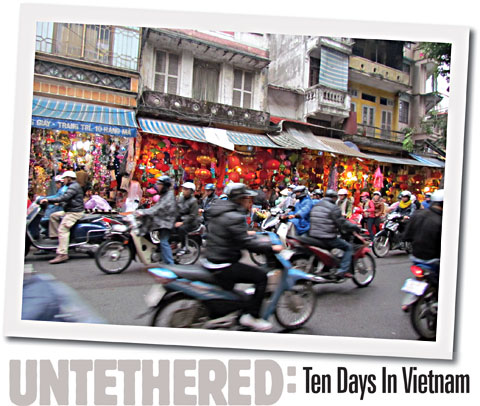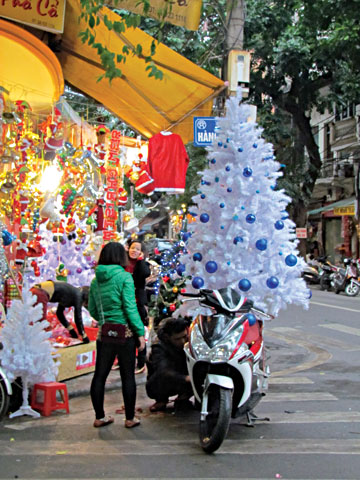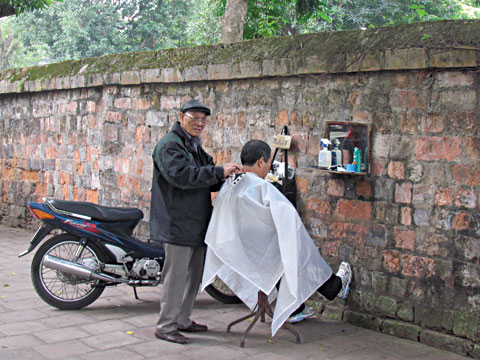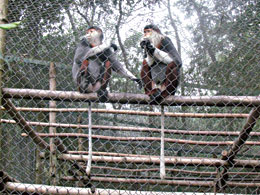 |
||||||||||||
|
May/June 2014
BY MARY BRUZZESE In late November, almost twenty-four hours after leaving the States, I, along with three other women, arrived utterly exhausted at Noi Bai International Airport in Hanoi to begin our ten-day visit to Vietnam. Our hotel, the Hanoi Moment, arranged for a shuttle to pick us up and drive us forty-five minutes into the heart of the city’s Old Quarter. Upon arrival we were greeted by a young, smiling staff and taken into the immaculate, chic lobby, where we were given fresh mango juice before being shown to our rooms.
We began our first morning in our hotel café with breakfast and several cups of Vietnamese coffee. Strong without bitterness, it is exceptional. After chatting with the hotel staff and getting ideas about what to see, we went out into the city. Perhaps it was the excitement of being on the other side of the world—or maybe the endless cups of coffee—but none of us experienced any serious jet lag that first morning. Even if we had, walking into the frenetic streets of Hanoi’s Old Quarter for the first time would have shocked the jet lag right out of us. We were immediately thrust into the chaos: a labyrinth of narrow streets teeming with cars, bicycles, pedestrians, and thousands upon thousands of motorcycles; a cacophony of honking horns and revving engines, along with voices raised to be heard over them; the smell of exhaust and frying food wafting through the air.
Although hectic, the traffic moves slowly. That’s a good thing, considering there are hardly any traffic lights aside from those at major intersections. All you can do is take a deep breath, walk into the street, and hope that the drivers won’t run you over. We received good advice from a local: Cross at an angle, don’t stop, and try to make eye contact with the drivers coming toward you. There must be some method to the madness, because in all our time in Hanoi we never saw a pedestrian get hit, and only once did we witness an accident: A motorcycle backed out of an alley and into another riding down the street. The drivers gave their bikes a quick once-over, nodded to each other, and went on their way. Some of the many street vendors approach tourists, and taxi and tuk-tuk drivers constantly offer rides. But a polite “no, thank you” usually does the trick. Some are a bit more aggressive, though. One sly woman came up behind my cousin and put her pineapple-laden quang gánh across her shoulders and her nón lá (conical hat) on her head, and told her to have someone take her picture. Of course, then she asked my cousin to buy some pineapples.
We were in Hanoi during Christmastime, and shops were selling shiny, gaudy decorations throughout the Old Quarter. On some streets, nearly every shop was selling Christmas decorations. We watched a woman buy a large artificial tree, tie it to her motorcycle, and ride away.
There is respite from the Old Quarter commotion. Central Hanoi is very walkable, so it doesn’t take long to wander into a quiet spot. The Temple of Literature is one such peaceful place. A fine example of traditional Vietnamese architecture, the temple is a walled complex of pavilions set among lily ponds, courtyards, and gardens filled with gnarled and twisted trees, flowers, and topiary animals. We happened to visit just as a graduation ceremony ended. Young men and women in caps and gowns, accompanied by their families, wandered among the gardens chatting and posing for photos.
The French influence can be seen in the architecture surrounding the lake, where narrow buildings and streets open onto sweeping, tree-lined boulevards and massive colonial structures. The streets surrounding the lake are lined with high-end stores, cafés, and coffee shops. Coffee shops are a favorite hangout of Hanoi hipsters lounging with laptops and cellphones, chatting with friends, or smoking cigarettes and people watching from balconies. Many sites surround the lake, including the Opera House and St. Joseph’s Cathedral. Also near the lake is the Sofitel Legend Metropole Hanoi, a famous colonial French hotel that we visited for high tea. This giant five-star hotel, built in 1901, is lavish inside and out. The staff was impeccably dressed, some of the women even donning pearls and lace gloves. Likewise—unlike us—most of the patrons were dressed to the nines.
The Fine Arts Museum houses Vietnamese art ranging from ancient to contemporary. Much of the art, by both men and women, deals with war. It was very apparent that, unlike much of the American public during the Vietnam War, virtually the entire population of Vietnam was involved in the war effort.
Hanoi’s traffic spikes to a maddening high in the evening. But after the rush, the volume diminishes. That doesn’t mean Hanoi goes quiet after the sun sets. There are still plenty of locals out and about, and there is a lot to do. Although some shops close at night, many stay open. The bustling Dong Xuan Market remains open and seems to extend endlessly with hundreds of stalls selling everything from cell phone covers, pet accessories, and jeans to stickers and coloring books to food. At night the lights of the city reflect off the surface of Hoan Kiem Lake. We visited the neighboring Thang Long Water Puppet Theater, which performs the ancient art form that originated in Vietnam’s Red River Delta. The set and lighting were beautiful, and the puppets gorgeously carved and painted. A live orchestra and vocalists performed traditional Vietnamese music. In addition to pastoral scenes depicting harvesting rice and fishing, ancient legends with fire-breathing dragons and phoenixes splashed across the set. There are plenty of night spots, ranging from dive bars to bass-thumping dance clubs. In theory, they close by midnight, but not all follow this rule. We were in a bar one night when the bartender pulled down the front metal shutter at curfew. Meanwhile, patrons continued to arrive through a back entrance. When we left, a woman with a flashlight led us out the back entrance to an alley behind the bar.
Halong Bay, a UNESCO World Heritage Site, is roughly a 3-1/2 hour drive east of Hanoi in the Gulf of Tonkin. Once we reached Halong City, the gateway to the bay, we went to Indochina Junk’s headquarters, where we met our guide and the thirteen other tourists who would be sharing our boat, the Dragon’s Pearl, with us for two nights. Once we boarded the boat, we sailed off through Halong Bay and into less-visited Bai Tu Long Bay. Nothing compares to the sublime scenery of Halong and Bai Tu Long Bays. Hundreds of towering jungle-cloaked pinnacles jut vertically out of the emerald water. As the sun sets, the limestone formations seem like mirages floating in a sea of glittering gold. We shared the bay only with local fisherman and the very infrequent tour boat. I sat mesmerized on the sunny upper deck as we drifted in the fairy-tale landscape, each passing panorama more glorious than the last. The bay was wonderfully peaceful; the only sounds were the chirps of birds, screeches of hawks echoing off the cliffs, and the occasional chug-chug of fishing boats. Legend has it that when the Vietnamese were facing invaders from the sea, a mother dragon and her children were sent to protect them. The dragons spat out jewels and pearls, which became hundreds of islands that blocked the invaders. After the invaders left, the dragons remained—the mother settling in Halong Bay and her children in Bai Tu Long Bay. In fact, Halong translates as “descending dragon.” We had one full day on the bay, during which we went to Vung Vieng, a fishing village where every home and structure, including a tiny school, is built on a floating dock. The villagers make a living by fishing or pearl farming. The homes were brightly colored, as were the fishing boats moored alongside. Villagers also get around in paddle boats, which some paddled with their feet. That evening we docked at Hon Co Island, where we could kayak, swim, or explore. As soon as we stepped onto the island, we were greeted by two playful dogs who romped up and down the beach together. Later that night our boat’s crew set up an elegant candlelit dinner for us inside the island’s Thien Canh Son Cave. To get to the cave, we climbed stairs straight up the island’s central mountain, where only a small hole in its side revealed the cave’s presence. As soon as we ducked through the entrance, however, the cave opened up into chambers full of sparkling stalactites and stalagmites. Two nights were hardly enough time on the bays. One could easily spend a week drifting along and exploring the hundreds of islands.
Although the Red River Delta industrial town of Ninh Binh, about two hours outside of Hanoi, isn’t much to see, its proximity to Cuc Phuong National Park, Van Long Nature Reserve, and other attractions makes it a useful base for exploring the surrounding scenery: craggy mountains looming above farms and rice paddies. Unfortunately for us, the rice had just been harvested, so where there normally would have been bright green paddies, we saw only brown water. But there was much green farmland among the paddies, full of water buffalo, cattle, goats, chickens, and thousands and thousands of white ducks. We stayed at the Emeralda Resort for three nights. As at the Hanoi Moment, we were warmly received by the staff and given hot tea before being shown to our bungalow. The huge resort sits a bit removed from central Ninh Binh amid rice paddies and mountains. To tour the surrounding area, we made arrangements through the incredibly helpful resort staff. We booked a day tour of Cuc Phuong National Park, Vietnam’s first national park, a forty-five minute drive away. Our private tour included a strenuous hike up and over mountains and through the jungle. Although misty air restricted vistas, it added a mysterious ambiance to the dense jungle, crowded with giant, ancient trees—including the famous 1,000-year-old “Old Tree”—fighting for space among enormous ferns and twisted, tangled roots and vines. We had the park largely to ourselves, aside from a small group of university students with whom we crossed paths at the Old Tree.
There were many species at the center, including gibbons and several varieties of langur. Most ignored us as we walked past them, and they continued to eat, groom one another, and cuddle their infants. But the gibbons swung around acrobatically. They like to show off for visitors, we were told. Before returning to the Emeralda, we took a boat ride through Kenh Ga, a fishing village tucked between lofty cliffs. As our boat drifted down the river, many children ran along the shore waving at us. Because our tour ran late and everyone was hungry, our guide arranged an impromptu visit to a restaurant in a tiny neighboring village. We were greeted by a chunky, jolly woman who spoke no English but was all smiles. We were treated to a feast, as she brought out several delicious dishes, heaping food onto our plates. She also brought us rice whiskey and glasses, and joined us for shots. She continued to pile food onto our plates and pour whiskey into our glasses until I had to turn my glass upside down. After the meal she brought coffee and plates of fresh fruit. As we stumbled from the restaurant, she gave us hugs and bananas. The following day we took a tour of Van Long Nature Reserve, just a five-minute walk from the resort. We went to the reserve’s boat dock where two small paddle boats took the four of us through the reserve. The area was beautiful: jagged mountains soaring straight up out of wetlands. Mists again provided a mystical aura. We saw many birds and had a few fleeting glimpses of the critically endangered Delacour’s langurs that inhabit the cliffs. The area was riddled with caves, one of which tunneled straight through the base of a mountain. We were able to paddle through, although at points the ceiling was so low we had to duck our heads. Bringing our visit full circle, we stayed at the Hanoi Moment the night before we flew home. The staff had gotten to know us; a young receptionist told us she would miss us very much. As we got into the airport van, the entire staff walked outside with us, and a few gave us hugs. As we pulled away, they stood on the sidewalk and waved goodbye.
Guidebooks we consulted include Vietnam (Lonely Planet, Eleventh Edition, 568 pp., $24.99)—information can also be found at Lonely Planet’s website, Vietnam, Cambodia & Laos Handbook (Footprint Handbooks, Fourth Edition, 512 pp., $25.95)—information also on their website and Vietnam & Angkor Wat (DK Eyewitness Travel, 312 pp., $25). Helpful websites include Fodor’s Travel, and TripAdvisor, for travel tips and information; Centers for Disease Control and Prevention, for health information; and the U.S. Vietnam Embassy, for information about obtaining visas.
|
||||||||||||
|
|
||||||||||||
|
||||||||||||
8719 Colesville Road, Suite 100, Silver Spring. MD 20910 | www.vva.org | contact us |
||||||||||||










 Motorcycles and bicycles are loaded with anything and everything: rice, live chickens, packing peanuts, hair accessories, flip-flops, toilets, and more. Women with quang gánh (two baskets hung from either end of a bamboo pole slung over the shoulder) loaded with fruit, vegetables, and flowers weave in and out of traffic. Rows of parked motorcycles crowd the sidewalks, with food vendors and their patrons crammed into any free space. And if you think the disarray on the streets makes your head spin, just look up: Crisscrossing at every angle from the Old Quarter’s narrow tube houses are tangled masses of telephone and electrical wires.
Motorcycles and bicycles are loaded with anything and everything: rice, live chickens, packing peanuts, hair accessories, flip-flops, toilets, and more. Women with quang gánh (two baskets hung from either end of a bamboo pole slung over the shoulder) loaded with fruit, vegetables, and flowers weave in and out of traffic. Rows of parked motorcycles crowd the sidewalks, with food vendors and their patrons crammed into any free space. And if you think the disarray on the streets makes your head spin, just look up: Crisscrossing at every angle from the Old Quarter’s narrow tube houses are tangled masses of telephone and electrical wires. The Old Quarter is truly a sensory wonderland and a shopper’s paradise. Shops selling similar products often are clustered together on a street or corner—one street is lined with shops selling silks and clothing; another, sunglasses; one, religious offerings; another, jewelry; and another, candy. The shops at one corner only sold mannequins. Every other shopkeeper seems to have caged songbirds hanging from the doorway or a friendly dog or cat lounging in it. The shopkeepers are welcoming and chatty, often interested in hearing about where you’re from and how you’re enjoying Vietnam.
The Old Quarter is truly a sensory wonderland and a shopper’s paradise. Shops selling similar products often are clustered together on a street or corner—one street is lined with shops selling silks and clothing; another, sunglasses; one, religious offerings; another, jewelry; and another, candy. The shops at one corner only sold mannequins. Every other shopkeeper seems to have caged songbirds hanging from the doorway or a friendly dog or cat lounging in it. The shopkeepers are welcoming and chatty, often interested in hearing about where you’re from and how you’re enjoying Vietnam.  Hoan Kiem Lake, its shores lined with gardens and trees, is quiet, lovely, and intimate. Parents doted on chubby toddlers, couples posed for photos, and teenagers whizzed by on skateboards, while giggling students and locals relaxed on park benches. A group of young women from a local university approached us and asked if they could practice their English. Before we went our separate ways, we took a picture together. After we posed arm in arm, the girls gave us hugs as they said goodbye.
Hoan Kiem Lake, its shores lined with gardens and trees, is quiet, lovely, and intimate. Parents doted on chubby toddlers, couples posed for photos, and teenagers whizzed by on skateboards, while giggling students and locals relaxed on park benches. A group of young women from a local university approached us and asked if they could practice their English. Before we went our separate ways, we took a picture together. After we posed arm in arm, the girls gave us hugs as they said goodbye. Many of the city’s museums are clustered around the lake, including the Vietnamese Women’s Museum. One floor documented the role of women in Vietnam’s history, with an emphasis on war, including the American War. The exhibit included several propaganda posters, along with displays highlighting women’s importance as fighters and even military leaders. One small exhibit, called “Heroic Mothers of Vietnam,” featured photographic portraits of the Vietnamese equivalent of America’s Gold Star Mothers.
Many of the city’s museums are clustered around the lake, including the Vietnamese Women’s Museum. One floor documented the role of women in Vietnam’s history, with an emphasis on war, including the American War. The exhibit included several propaganda posters, along with displays highlighting women’s importance as fighters and even military leaders. One small exhibit, called “Heroic Mothers of Vietnam,” featured photographic portraits of the Vietnamese equivalent of America’s Gold Star Mothers.

 We took a tour of the park’s Endangered Primate Rescue Center. The center has a huge, enclosed semi-wild area to test rehabilitated primates’ readiness to return to the wild. Many of the animals cannot safely return, however, and are permanent residents at the center, which also runs a successful breeding program.
We took a tour of the park’s Endangered Primate Rescue Center. The center has a huge, enclosed semi-wild area to test rehabilitated primates’ readiness to return to the wild. Many of the animals cannot safely return, however, and are permanent residents at the center, which also runs a successful breeding program.  Many visit Vietnam with a tour group. We, however, chose to go it alone. Many travelers to Vietnam also opt to move up or down the length of the country to visit as many places as possible. But this means constantly moving from place to place and spending only a night or two at each location. We opted to spend more time at fewer places. Going to Vietnam requires advance planning with visas, vaccinations, transportation, and avoiding rainy seasons. We found guidebooks and websites that were indispensable—not just in explaining what preparations needed to be made, but in helping us decide upon our itinerary.
Many visit Vietnam with a tour group. We, however, chose to go it alone. Many travelers to Vietnam also opt to move up or down the length of the country to visit as many places as possible. But this means constantly moving from place to place and spending only a night or two at each location. We opted to spend more time at fewer places. Going to Vietnam requires advance planning with visas, vaccinations, transportation, and avoiding rainy seasons. We found guidebooks and websites that were indispensable—not just in explaining what preparations needed to be made, but in helping us decide upon our itinerary.